|
|
|
Sort Order |
|
|
|
Items / Page
|
|
|
|
|
|
|
| Srl | Item |
| 1 |
ID:
141082
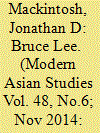

|
|
|
|
|
| Summary/Abstract |
Fist of Fury, starring Bruce Lee, debuted in Japan in 1974. Whilst its critical reception reflected its box-office success, a complex emotional reaction is nevertheless detectable towards the film's unsympathetic portrayal of the Japanese. This paper will explore this reaction and suggest that a post-colonial angst was piqued, one that betrayed fundamental shifts in current racial, erotic, cultural, moral, and historical understandings of Japanese manliness. At one level, the response to Lee is a hermeneutic cue into the manifold ways that this angst was constructed through contesting understandings of an emergent China and unresolved memories concerning failed imperial Japanese adventure. At another level, the phenomenon of Lee's Japanese reception points to longer-term shifts in the visual-cultural representation of masculinity: vulnerability as articulated in the cinema's ‘new man’, male nudity as ‘discovered’ in women's magazines, and most potently, modern Japanese manliness to challenge American neo-colonial hegemony. It is this panorama of masculinity that this paper seeks to open through an inter-disciplinary survey of a variety of media—film, pulp fiction, women's magazines, and homo porn; a panorama into which Bruce Lee exploded on screen, alerting us to the images and contradictory aspirations that script a visual poetry of Japanese manliness.
|
|
|
|
|
|
|
|
|
|
|
|
|
|
|
|
| 2 |
ID:
141084


|
|
|
|
|
| Summary/Abstract |
This paper explores how the government of the People's Republic of China (PRC) has been trying to incorporate post-1997 Hong Kong into the framework of a Greater China. The construction of two ‘narratives’ are examined: the grand narrative of Chinese history in secondary school textbooks in Hong Kong; and the development of a new regional framework of the Pearl River Delta. The first narrative, which focuses on the past, signals the PRC government's desire to inculcate through education a deeper sense of collective identity as patriotic citizens of China amongst residents of Hong Kong. The second narrative, which represents a futuristic imagining of a regional landscape, rewrites the trajectory of Hong Kong by merging the city with the Pearl River Delta region. However, these narrative strategies have triggered ambivalent responses from people in Hong Kong, especially the generations born after 1980. In their discursive battles against merging with the mainland, activists have sought to instil a collective memory that encourages a counter-imagination of a particular kind of Hong Kong that draws from the pre-1997 past. This conflict pits activists and their supporters against officials in the local government working to move Hong Kong towards integration with greater Guangdong and China at large. But the local resistance discourses are inadequate because they are constrained by their own parochial visions and colonial nostalgia.
|
|
|
|
|
|
|
|
|
|
|
|
|
|
|
|
| 3 |
ID:
141083


|
|
|
|
|
| Summary/Abstract |
Museums have long been thought to be vital contributors to nation building and the creation of identity narratives, yet the stories they tell must be negotiated within the constraints set by differing levels of interpretive freedom. This paper examines how museum exhibitions changed between 1982 and 2009 at the museums serving the five capital sites of the non-Chinese Kitan-Liao dynasty (907–1125). While some of these places, such as Beijing, have now become unquestionably central to the national narrative, others are deep in rural areas and are peripheral even to provincial concerns. Exhibitions at these five museums vary considerably in the degree to which they either consider the Kitan and the Liao dynasty in their own right or attempt to place them within a national narrative. The wide range of approaches reflects the differing present-day concerns of the museums’ host locations, as well as the new multivocality that is developing in—among other places—China's regional cultural institutions.
|
|
|
|
|
|
|
|
|
|
|
|
|
|
|
|
| 4 |
ID:
141089
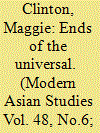

|
|
|
|
|
| Summary/Abstract |
Fascist Italy's 1935 invasion of Ethiopia and the League of Nations’ handling of the crisis resonated strongly in Nationalist China, where it recalled the League's failure to thwart Japan's claims to Manchuria in 1931. As these two crises unfolded, the League became a nexus around which Nationalist Party debates about the position of colonized and semi-colonized countries within the extant world order crystallized. Party adherents reflected on China's and Ethiopia's positions as independent nation states with limited territorial integrity or juridical autonomy, and assessed this situation in light of their respective League memberships. While party liberals continued to view the League as a flawed but worthwhile experiment in global governance, newly-emerged fascist activists within the party denounced it as an instrument for curtailing the sovereignty of weak nations. From these conflicting views of the League, it can be discerned how Nationalist disunity was partially grounded in disagreements over the nature and ideal structure of the global order, and how Chinese fascists agitated to escape from modern structures of imperialist domination while reiterating the latter's racial and civilizational exclusions.
|
|
|
|
|
|
|
|
|
|
|
|
|
|
|
|
| 5 |
ID:
141088
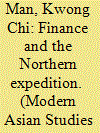

|
|
|
|
|
| Summary/Abstract |
This paper looks at the problems faced by the Chinese silver-backed currencies in Manchuria during the period of Northern Expedition (1925–1928), the Chinese attempt to overcome these problems, and the reasons for its failure. Manchuria was a peculiar territory during the interwar period (1919–1939), where several currencies, backed by silver or gold, competed against one another. The Chinese silver banknote, first introduced at the turn of the twentieth century, was challenged by gold-backed Japanese yen issued by the Bank of Korea, and by the Russian ruble. This competition was set in the context of the struggle for political control over the area between China (the Qing Dynasty and its successor, the Chinese Republic), Russia (and its successor the Soviet Union), and the Japanese Empire, as well as the war between the southern Nationalists (Kuomintang) and the militarists (warlords) who controlled the Chinese central government in Beijing and Manchuria. This paper suggests that the difficult financial situation determined the course followed by the warlords, and that their failure was the result of the complex regional context, and the failures in their military strategy rather than of their fiscal policy.
|
|
|
|
|
|
|
|
|
|
|
|
|
|
|
|
| 6 |
ID:
141087
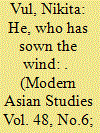

|
|
|
|
|
| Summary/Abstract |
This article deals with the Sino–Soviet conflict of 1925–26 over the Chinese Eastern Railway, with special attention given to its background and consequences. In 1924, the Chinese Eastern Railway became a joint venture between the Soviet Union and China, creating fresh friction between the joint Soviet and Chinese managers which culminated in general manager A.N. Ivanov's prohibition on transporting military cargoes and troops, and Ivanov's arrest by Manchurian warlord-general Zhang Zuolin. Some scholars and diplomatists have viewed Ivanov's prohibition and the simultaneous rebellion by Chinese general Guo Songling against Zhang as a Soviet attempt to replace Zhang with a more manageable warlord. But this article argues that although the prohibition—a typical instance of back-and-forth Soviet diplomacy—was a coincidence, it was primarily the result of Soviet ambassador Lev M. Karakhan's tough stance and his rash decision-making, undertaken without seeking advice from Moscow. Zhang's victory in the 1926 clash convinced the Chinese that they had the power to take repressive measures against the Soviet Union's citizens and institutions, which led to the Sino–Soviet conflict of 1929 and exacerbated Japanese alarm over the Soviet's increasing strength in the region. This was to be a factor in the takeover of Manchuria in 1931 by Japan's Guandong Army, which eventually led to global war. This article, therefore, deals with the origins of world-changing events and thus is interesting to Modern Asian Studies’ wider readership.
|
|
|
|
|
|
|
|
|
|
|
|
|
|
|
|
| 7 |
ID:
141090


|
|
|
|
|
| Summary/Abstract |
This paper aims to provide a new perspective on the relationship between Nationalist Party (GMD) cadres and Chinese intellectuals. By studying the Central Politics School, a major GMD political training institute for professional party cadres, I hope to reassess the nature of the GMD one-party state and remind researchers of the difficult choices it faced between backing party-liners needed for the political struggle and accommodating depoliticized intellectuals needed for public administration. This paper will argue that GMD political impotence in competition with the Chinese Communist Party (CCP) was due less to an inadequate recruitment of capable experts than to the over-specialization of its well-trained cadres on technical tasks. In fact, the cadres from the Central Politics School generally resembled those considered to be ‘intellectuals’ at educational level and in ideology. This compels us to reconsider how to define ‘intellectuals’ and whether they were as uniformly alienated from the one-party state as most of the scholarly literature suggests.
|
|
|
|
|
|
|
|
|
|
|
|
|
|
|
|
| 8 |
ID:
141081


|
|
|
|
|
| Summary/Abstract |
This article inquires into the cultural and political nexus of secular (stage) magic, modernity, and Orientalism at the turn of the twentieth century. It argues that these three arenas interacted in important and special ways to both shape and reflect the politics of knowledge of the period. In doing so, it draws attention to the ways in which secular magic has been overlooked as a historical phenomenon and highlights its utility in furthering our understanding of the great problematics of modernity and Orientalism; in particular, it suggests that magic actually provides an unusually vibrant and clear lens through which to view the politics of the Other and through which to explore issues of tradition and the modern. Focusing on two historical cases—the ‘Indian Rope Trick’ challenge issued by the Magic Circle in the 1930s and the astonishing ‘duel’ between the ‘Chinese’ magicians Chung Ling Soo and Ching Ling Foo in 1905—this article considers the ways in which discourses of origination, popular ideas about esotericism and the ‘mystic East’, and questions of technical competence interacted and competed in the culture politics of the early twentieth century.
|
|
|
|
|
|
|
|
|
|
|
|
|
|
|
|
| 9 |
ID:
141086
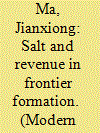

|
|
|
|
|
| Summary/Abstract |
This research reviews the formation of the Yunnan-Burma frontier since the 1720s, when the Qing government reformed the administrative systems from chieftainships to official counties in the middle and southern Yunnan mountains areas. One of some crucial political changes was the policy of salt revenue which directly stimulated large scale ethnic resistance in the region of salt wells. However, the social political context of continuing ethnic conflicts was not only rooted in the reshaping of the salt-consuming districts, but also rooted in social changes in the Yunnan-Burma borderland because of increasing Han Chinese immigration and their penetration into mining, long distance trade and local agriculture. In order to successfully control mountain resources as the base of revenue, the Qing government continued to gradually integrate native Dai chieftains into official counties. Local resistance continued and reached a peak from the 1790s to the 1810s. Pushed by the Qing government, and with the collaboration of different social actors, the synthesized mobilization of frontier formation had made ethnic politics a main style of social political reconstruction, even if commercial exchange, long distance trade, and demographic reshaping also continued to be mixed with ethnic politics as another layer of the Yunnan-Burma frontier formation.
|
|
|
|
|
|
|
|
|
|
|
|
|
|
|
|
| 10 |
ID:
141085
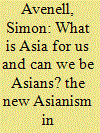

|
|
|
|
|
| Summary/Abstract |
This paper traces the development of the ‘New Asianism’ in Japan over the past quarter of a century. It identifies three broad trajectories or normative positions in the debate: those advocating the replication of a Japanese model in Asia, those in favour of a genuine community of equals, and those who see Asia as the only future for Japan and as a solution for the country's economic and social problems. The paper argues that the evolution and shifting prominence of each trajectory over time is indicative of the ways globalization and regionalization are impinging on imaginations of the nation and facilitating novel perspectives on East Asia in Japan. Although the nation-state is, and will probably remain, an important force behind Japan's relations in Asia for the foreseeable future, the New Asianism may be indicative of its gradual relativization and the beginning of a new, more multidimensional understanding of Asia in Japan.
|
|
|
|
|
|
|
|
|
|
|
|
|
|
|
|
|
|
|
|
|